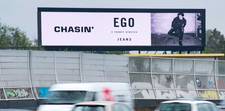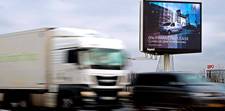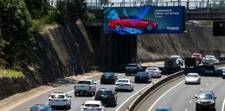As of 2016, Billboard Insider estimated that there were as many as 1,000 independent billboard operators in the United States, and many thousands more exist around the world. These networks may only represent a handful of faces or displays each, but operate some of the hidden gems of the out-of-home world.
For many independent operators, finding ways to attract big brands, improve operational efficiency, and future-proof their networks are top concerns. Networks that transition to digital can start addressing these issues by choosing the right digital signage software.
Increasing revenue by enabling dynamic campaigns
Creatively, the digital out-of-home (DOOH) medium offers a lot more possibility than static billboards and posters. DOOH can include motion and brighter colours, but also offers the opportunity to use data for impressive campaigns. Data integration opens the door to dynamic content, which is content that can change in response to external conditions. This means that an ad can change in response to the developing score in the home team’s game, that different creatives for a single ad campaign can be played depending on the time of day, etc. This provides a more interesting and relevant experience for audiences.
Example: This J.C. Decaux video demonstrates examples of dynamic campaigns run on a screen in Chicago. The ads themselves change in response to a number of external conditions.
Enabling dynamic campaigns takes a bit more technical setup than just displaying static imagery up on a screen, but there’s an upside. Networks that support dynamic creative can charge an increased rate for those kinds of campaigns. They’re also in higher demand for large brands with big ideas they hope will make a splash. In other words, there’s a good financial incentive for independent network operators to ensure their screens have what it takes to do dynamic.
The first step in providing broad support for dynamic campaigns is for network operators to get the right software. Choosing an extensible platform with an open API will make it possible to deliver on all sorts of dynamic campaigns buyers may want to run.
Integrating static and digital inventory in a single system
Digital out-of-home (DOOH) is an exciting space, but it’s an expensive process to transition to digital. Just one digital billboard can cost tens of thousands of dollars to buy and install, and hundreds or thousands to maintain each year. Understandably, many independent outdoor advertising companies are making the transition gradually.
This creates a bit of an operational challenge, in that the management and sales processes differ. Static media sales involve a single entity buying inventory for a prolonged period, priced according to the likely number of impressions. Digital, however, typically involves many entities buying up ad slots on one or more displays. The pricing models for these media can be diverse. Some buyers prefer to buy according to audience or the type of screen, or just whatever they can fit in their budget.
The old industry standard of Excel is not ideal for managing these sorts of mixed demands. Outdoor advertising companies can instead find the solution they need in dedicated sales tools for the OOH space. These help to streamline the sales process by offering instant access to booking data. Users can quickly check availability and build proposals for digital and static inventory, or mixtures of the two, in real-time.
It’s also worth noting that media buyers today often look to buy both static and digital inventory as part of larger, multichannel advertising campaigns. Media owners that integrate all of their inventory into a common system will make it easier for themselves to book and deliver these sorts of campaigns for buyers.
Getting on board with the programmatic future
Programmatic transactions are becoming more common in the DOOH industry. These automate the transaction and delivery of ads so that they only appear before specific audiences or under specific conditions. Similar to dynamic campaigns, programmatic can help achieve greater relevance and impact.
Example: In order to promote its pick-up service, Foodora used programmatic DOOH as part of a multichannel, targeted campaign that reached more than a million impressions.
Independent outdoor ad networks that adopt programmatic can realize a few key benefits.
First, the enhanced targeting and relevance of programmatic campaigns justify a higher price. Operators can easily increase revenue on their inventory with programmatic.
Second, programmatic can widen the pool of potential buyers. Many national and international brands look for opportunities to incorporate DOOH into their campaigns. Having programmatic access to unique inventory held by independent companies can be very attractive.
Finally, it provides a convenient way to optimize yield. Networks can automatically fill unsold slots with media from high bidders or trusted buyers with pre-arranged pricing.
To achieve these benefits, networks should adopt a programmatic platform that connects with a variety of demand-side platforms (DSPs) used by buyers. Opting to go with a closed system will allow programmatic sales only through a smaller, single source of demand. This might lock out major buyers who choose to work through major DSPs that connect to many digital screens around the world.
Ensuring networks deliver strong proof-of-play reporting
The DOOH medium is getting more capable and being used for more interesting and complex campaigns. At the same time, media buyers are demanding firm proof that the campaigns they book are actually being delivered. In order to secure a bright future for a digital network, independent operators need to meet this demand.
Fortunately, proof-of-play (PoP) functionality is not hard to come by. Leading digital signage software platforms today typically bake in some sort of PoP feature. It is important to note, however, that few platforms have conducted independent audits to confirm that their data are accurate. When selecting digital signage software, evaluating proof-of-play functionality specifically is advisable.
Having strong proof-of-play capability is effectively a prerequisite for many of the other opportunities in the DOOH space, such as delivering dynamic or programmatic campaigns. It’s also particularly important for landing opportunities with big-name buyers. Select the right digital signage software to ensure you get data of a quality that opens doors.
Optimizing DOOH networks for efficiency
One of the beauties of DOOH is that, with the right setup, it’s easy to manage even large networks of screens with minimal effort. For independent DOOH networks operating with small teams, finding ways to achieve this efficiency is a big benefit.
The critical step is to use content management software (CMS) to automate as much scheduling as possible. Playlist-based software can handle scheduling, but is inefficient and leaves room for user error. Buyers often want to keep their ads separate from competitors’, or want a quick correction made to media that was previously submitted. Addressing these concerns completely can be quite time consuming when working with multiple playlists.
An automated CMS, on the other hand, simplifies the process. Network operators can establish rules about which content should be played when, along with any exceptions. Once these rules are established, all content is scheduled and delivered appropriately. Given the complexities of scheduling outdoor advertising, this leads to significant time savings that compound the larger a network gets.
Do you want to learn what the Broadsign platform can do for your digital signage?
Book your personalized demo today.










